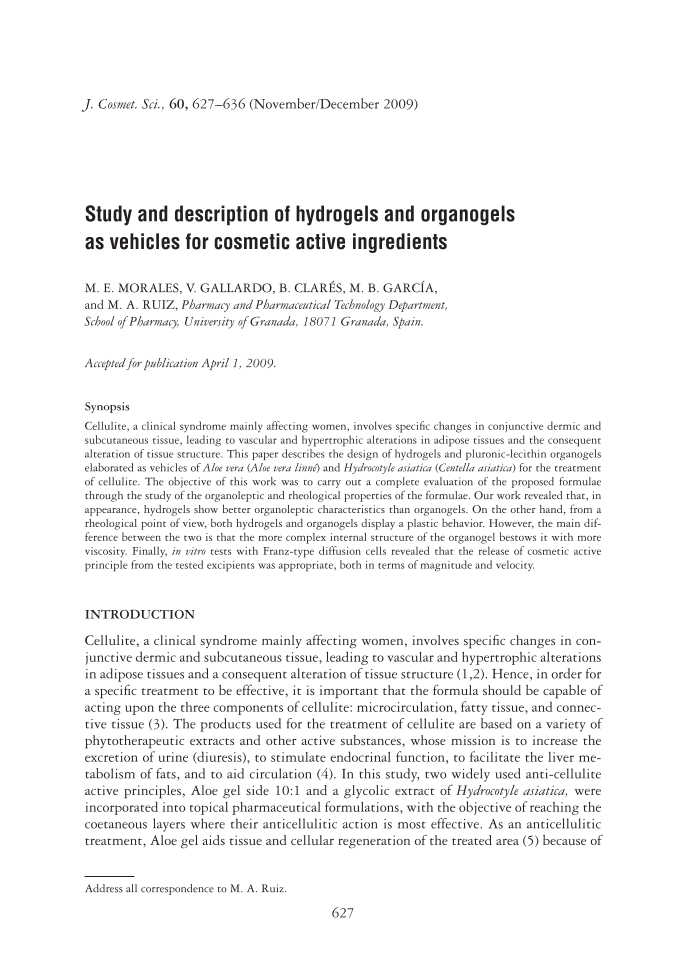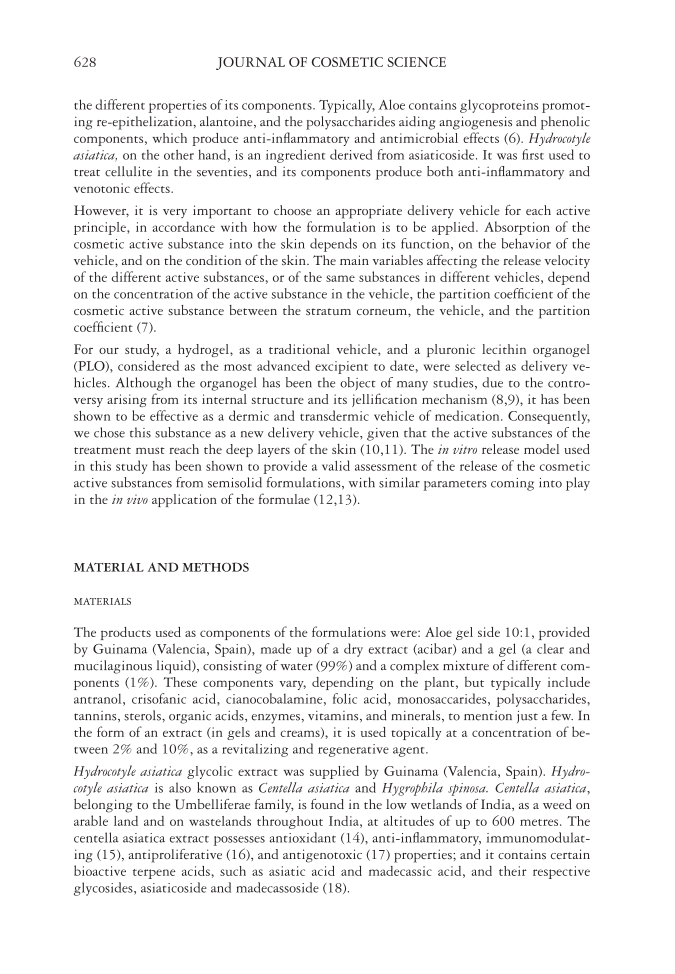J. Cosmet. Sci., 60, 627–636 (November/December 2009) 627 Study and description of hydrogels and organogels as vehicles for cosmetic active ingredients M. E. MORALES, V. GALLARDO, B. CLARÉS, M. B. GARCÍA, and M. A. RUIZ, Pharmacy and Pharmaceutical Technology Department, School of Pharmacy, University of Granada, 18071 Granada, Spain. Accepted for publication April 1, 2009. Synopsis Cellulite, a clinical syndrome mainly affecting women, involves specifi c changes in conjunctive dermic and subcutaneous tissue, leading to vascular and hypertrophic alterations in adipose tissues and the consequent alteration of tissue structure. This paper describes the design of hydrogels and pluronic-lecithin organogels elaborated as vehicles of Aloe vera (Aloe vera linné) and Hydrocotyle asiatica (Centella asiatica) for the treatment of cellulite. The objective of this work was to carry out a complete evaluation of the proposed formulae through the study of the organoleptic and rheological properties of the formulae. Our work revealed that, in appearance, hydrogels show better organoleptic characteristics than organogels. On the other hand, from a rheological point of view, both hydrogels and organogels display a plastic behavior. However, the main dif- ference between the two is that the more complex internal structure of the organogel bestows it with more viscosity. Finally, in vitro tests with Franz-type diffusion cells revealed that the release of cosmetic active principle from the tested excipients was appropriate, both in terms of magnitude and velocity. INTRODUCTION Cellulite, a clinical syndrome mainly affecting women, involves specifi c changes in con- junctive dermic and subcutaneous tissue, leading to vascular and hypertrophic alterations in adipose tissues and a consequent alteration of tissue structure (1,2). Hence, in order for a specifi c treatment to be effective, it is important that the formula should be capable of acting upon the three components of cellulite: microcirculation, fatty tissue, and connec- tive tissue (3). The products used for the treatment of cellulite are based on a variety of phytotherapeutic extracts and other active substances, whose mission is to increase the excretion of urine (diuresis), to stimulate endocrinal function, to facilitate the liver me- tabolism of fats, and to aid circulation (4). In this study, two widely used anti-cellulite active principles, Aloe gel side 10:1 and a glycolic extract of Hydrocotyle asiatica, were incorporated into topical pharmaceutical formulations, with the objective of reaching the coetaneous layers where their anticellulitic action is most effective. As an anticellulitic treatment, Aloe gel aids tissue and cellular regeneration of the treated area (5) because of Address all correspondence to M. A. Ruiz.
JOURNAL OF COSMETIC SCIENCE 628 the different properties of its components. Typically, Aloe contains glycoproteins promot- ing re-epithelization, alantoine, and the polysaccharides aiding angiogenesis and phenolic components, which produce anti-infl ammatory and antimicrobial effects (6). Hydrocotyle asiatica, on the other hand, is an ingredient derived from asiaticoside. It was fi rst used to treat cellulite in the seventies, and its components produce both anti-infl ammatory and venotonic effects. However, it is very important to choose an appropriate delivery vehicle for each active principle, in accordance with how the formulation is to be applied. Absorption of the cosmetic active substance into the skin depends on its function, on the behavior of the vehicle, and on the condition of the skin. The main variables affecting the release velocity of the different active substances, or of the same substances in different vehicles, depend on the concentration of the active substance in the vehicle, the partition coeffi cient of the cosmetic active substance between the stratum corneum, the vehicle, and the partition coeffi cient (7). For our study, a hydrogel, as a traditional vehicle, and a pluronic lecithin organogel (PLO), considered as the most advanced excipient to date, were selected as delivery ve- hicles. Although the organogel has been the object of many studies, due to the contro- versy arising from its internal structure and its jellifi cation mechanism (8,9), it has been shown to be effective as a dermic and transdermic vehicle of medication. Consequently, we chose this substance as a new delivery vehicle, given that the active substances of the treatment must reach the deep layers of the skin (10,11). The in vitro release model used in this study has been shown to provide a valid assessment of the release of the cosmetic active substances from semisolid formulations, with similar parameters coming into play in the in vivo application of the formulae (12,13). MATERIAL AND METHODS MATERIALS The products used as components of the formulations were: Aloe gel side 10:1, provided by Guinama (Valencia, Spain), made up of a dry extract (acibar) and a gel (a clear and mucilaginous liquid), consisting of water (99%) and a complex mixture of different com- ponents (1%). These components vary, depending on the plant, but typically include antranol, crisofanic acid, cianocobalamine, folic acid, monosaccarides, polysaccharides, tannins, sterols, organic acids, enzymes, vitamins, and minerals, to mention just a few. In the form of an extract (in gels and creams), it is used topically at a concentration of be- tween 2% and 10%, as a revitalizing and regenerative agent. Hydrocotyle asiatica glycolic extract was supplied by Guinama (Valencia, Spain). Hydro- cotyle asiatica is also known as Centella asiatica and Hygrophila spinosa. Centella asiatica, belonging to the Umbelliferae family, is found in the low wetlands of India, as a weed on arable land and on wastelands throughout India, at altitudes of up to 600 metres. The centella asiatica extract possesses antioxidant (14), anti-infl ammatory, immunomodulat- ing (15), antiproliferative (16), and antigenotoxic (17) properties and it contains certain bioactive terpene acids, such as asiatic acid and madecassic acid, and their respective glycosides, asiaticoside and madecassoside (18).
Purchased for the exclusive use of nofirst nolast (unknown) From: SCC Media Library & Resource Center (library.scconline.org)

































































































